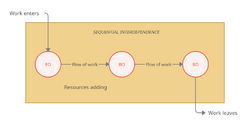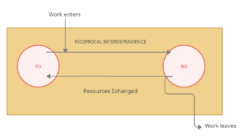Pooled, Sequential & Reciprocal Interdependence
Written by Tolga Azgun
Contents |
Abstract
Large scale projects encompassing various cross functional business units or teams have been characterized through their structural complexity.These complexities occur due to uncertainties which often is a direct consequence of vacillating resources (e.g., insufficient information flow) streaming throughout the project team.[1] These resources vary from team to team and can be crucial for the success of the overall performance.These interlinkages of workflow between groups were conceptualized by Thompson (1967) [2] naming them “interdependencies”. The term can be defined as the extent to which groups, business units or teams are interdependent with one another and are essentially dependent upon the action of others for their success. Interdependencies were categorized according to the severity of their dependence to one another. An additional area of interest for scholars has been external interdependencies.(e.g., buyer-supplier relationships) These relationships indicate specific firm level dependencies where being dependent on another is seen as an integral part and as “boundary spanners” for successful cooperation between companies. [3] However, this article aims to illustrate dependencies from an inter-organisational point of view, in which contrasting historic concepts of interdependencies will be reviewed. Furthermore, it is aimed to highlight the groundwork of the notion constructed by Thompson (1967)[4] in introducing the following concepts: pooled, sequential, and reciprocal interdependence. In addition, the article will outline the need of differing coordination methods for varying interdependency types based on the intensity levels to reduce the uncertainties which arises through complex workflow patterns.
Big Idea
J.D Thompson’s work Organizations in Action” is seen as the foundation of characterizing organizational groups and has been inspirational for scholars studying the organizational design field. [5] Consequently, elementary theories of the book “Organizations in Action” developed itself into having universal acceptance within the field.
As the adoption of groups and teams is increasing within organizations [6] it is essential to realize the effect of different types of interdependences on group control mechanisms and results. Besides the work of Thompson (1967), much scholar’s research has been investigating the value of “management control” processes to complement synergies of teams and business units. [7] Adler’s (1995)[8] main research has been focusing on how coordination exigencies of interdependences differ over the time of a product development project’s lifecycle. The results showed that the growing innovation of a product and process scope needed more interactive management instruments. Ambos and Schegelmilch (2007)[9] have laid their focus on the effects of interdependence levels and respective control mechanisms like “centralization, formalization and socialization” and found out that with an expanding degree of interdependence the use of these measures were also growing. Macintosh and Daft’s (1987)[10] center of attraction was to detect the effect of differing formal control mechanisms according to interdependence models. The summarized outcome of the study presented that, in growing pooled interdependences the usage of classic operating mechanisms grew, whereas the usage of “setting up budgets and statistical reports” declined. On the other hand, in an expanding scope of sequential interdependences, the adoption of “budgets and statistical reports” have shown an increase. However, on intensifying reciprocal interdependences the use of both classic operating mechanisms as well as budgets, statistical reports have dropped. In general, the outcome of ongoing research has proven that high level interdependences among teams requires more control. This is mainly because of the difficulty in reviewing the particular input of a sub team to the general project success while actions and resources commonly influence each unit’s performance.[11] Therefore, planning and a suitable coordination between units in a project is critical in apportioning limited resources which could potentially hinder arising disputes for teams facing uncertainties. A suitable coordination strategy would allow a copious knowledge flow throughout the entire project which is essential for a flawless operation. [12]
Pooled, Sequential & Reciprocal Interdependecies According to J.D.Thompson
Interdependence can be described as the degree to which responsible units are contingent to one another because of the allocation or trade of mutual resources and actions to carry out objectives.[4] As mentioned previously, the most popular systematic classification of task interdependence was brought in by J.D. Thompson who detected three types of interdependence - pooled, sequential and reciprocal interdependence.
Pooled Interdependence

A pooled interdependency is the least intense dependency type and has the largest physical dispersal of team members out of the three proposed by Thompson. Thompson associated the mediating technology type with the organizational characteristics of pooled interdependence. It occurs when project teams split comparable resources and tasks but continue to work independently. However, the outcome of each member affects the whole project performance but does not hinder anyone else to proceed with their activities. Everyone of the team contributes to the overall performance with distinguished efforts and is backed by the entire team. Autonomous activities of each individual usually run parallelly and resources are allocated by a routine pool. Merging homogeneous resources and actions is mostly compelled by “economies of scale” to reduce costs. Therefore, this kind of resource interdependency originates when a great degree of consistency of resources are ready for use to accommodate the needs for taking decisions. The results can be mostly predicted beforehand.[1]
The cost of coordination for pooled resource and task interdependencies is relatively low compared to its contraries. This is mainly because of the low-level management requirements. The need of active collaboration and communication is little. One of the main mechanisms is driving standardization in patterned workflows or in operation processes throughout units. In pooled interdependencies, it is crucial to maintain the devotion of each individual by reminding them how their input will be unified at the end result. Integrating a “reporting process” in which the decision makers or managers can assign a specific part of the total project to a team member, having routine team discussion where processes and regulations are reviewed could boost the motivation of the members. A gymnastics team is one of the many examples which could represent a pooled interdependence where each team member has to actively render a distinct contribution in order to succeed in team rankings. Another example is a school where different teachers each take actively part to accomplish the overall goal, which is that pupils learn, they are however all independent in their classes while teaching to their students.
Sequential Interdependence
Explaining Sequential interdependence with a respective example & figure

Reciprocal Interdependence
Explaining reciprocal interdependence with a respective example & figure

Coordinating Interdependence in Cross-Functional Project Teams
Standartization of Work Processes
Explaining the coordination method
Planning and Scheduling
Mutual Adjustments
Limitations of the Construct
critically reflect on the tool/concept/theory. When possible, substantiate your claims with literature
Annotated Bibliography
References
- ↑ 1.0 1.1 1.2 1.3 1.4 "F. Ter Chian Tan, S. L. Pan and M. Zuo, "Realising platform operational agility through information technology–enabled capabilities: A resource‐interdependence perspective," INFORMATION SYSTEMS JOURNAL, vol. 29, no. 3, pp. 582-608, 2019
- ↑ "B. Victor and R. S. Blackburn, "Interdependence: An Alternative Conceptualization," The Academy of Management Review, vol. 12, no. 3, pp. 486-498, 1987
- ↑ "R. H. Chenhall and D. Morris, "THE IMPACT OF STRUCTURE, ENVIRONMENT, AND INTERDEPENDENCE ON THE PERCEIVED USEFULNESS OF MANAGEMENT ACCOUNTING SYSTEMS," Accounting Review, vol. 61, no. 1, pp. 16-135, 1986
- ↑ 4.0 4.1 J. D. Thompson, Organizations in Action. Social Science Bases and Administrative Theory, New York: McGraw-Hill, 1967.
- ↑ J. R. Galbraith, Organization Design. Reading, Mass, Massachusetts: Addison-Wesley, 1977.
- ↑ S. R. Barley, "Explaining pooled interdependence with a respective example & figure," Administrative Science Quarterly, vol. 35, no. 1, p. 61, 1990.
- ↑ J. Frost, K. Bagban and R. Vogel, "Managing Interdependence in Multi-business Organizations : A Case Study of Management Control Systems," Schmalenbach Business Review, vol. 17, no. 2, pp. 225-260, 2016
- ↑ P. Adler, "INTERDEPARTMENTAL INTERDEPENDENCE AND COORDINATION - THE CASE OF THE DESIGN/MANUFACTURING INTERFACE," Orhanization Science, vol. 6, no. 2, pp. 147-167, 1995.
- ↑ B. Ambos and B. B. Schlegelmilch, "Innovation and control in the multinational firm: A comparison of political and contingency approaches," Strategic Management Journal, vol. 28, no. 5, pp. 472-486, 2007
- ↑ N. Macintosh and R. Daft, "MANAGEMENT CONTROL-SYSTEMS AND DEPARTMENTAL INTERDEPENDENCIES - AN EMPIRICAL-STUDY," Accounting Organizations and Society, vol. 12, no. 1, pp. 49-61, 1987
- ↑ V. Blazevic and A. Lievens, "Learning during the new financial service innovation process – antecedents and performance effects," Journal of Business Research, vol. 57, no. 4, pp. 374-391, 2004.
- ↑ C. Tomkins, "Interdependencies, trust and information in relationships, alliances and networks," Accounting, Organizations and Society, vol. 26, no. 2, pp. 161-191, 2001
- ↑ "Détienne, F. (2006). Collaborative design: Managing task interdependencies and multiple perspectives. Interacting with Computers, 18(1 SPEC. ISS.), 1-20. doi:10.1016/j.intcom.2005.05.001